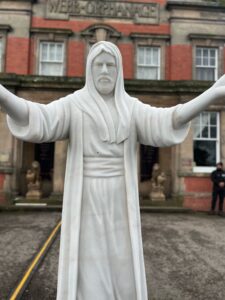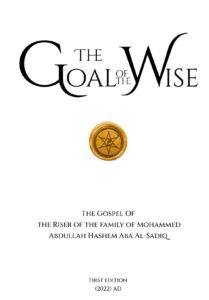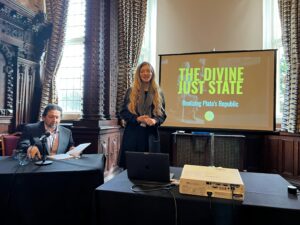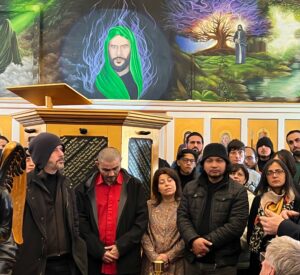AHMADI RELIGION OF PEACE AND LIGHT TIMELINE
1968 (March 21): Ahmed al-Hassan was born in Basra, Iraq.
1983 (July 27): Abdullah Hashem was born in Indiana, United States, from an Egyptian father and an American mother.
1999: Ahmed al-Hassan announced that he was the prophesied Yamani and a messenger from Imam Mahdi.
2002: A severe persecution of the al-Hassan movement started in Iraq and Iran.
2007: Ahmed al-Hassan was last seen and photographed in Iraq, after which he went into hiding.
2012: A faction known as the “White Banners” headquartered in Najaf, Iraq, started publishing, including via Facebook, messages from Ahmed al-Hassan that others regarded as apocryphal.
2015: Abdullah Hashem proclaimed the appearance of Imam Mahdi and that he was in contact with al-Hassan. He established “the Black Banners of the East,” known later as the Ahmadi Religion of Peace and Light.
2019: Hashem and some seventy followers established a community in a farm called Bergslagsgården in Sävsjön near Hällefors, Sweden.
2019: The Ahmadi Religion of Peace and Light was officially established in the United States as a 501c3 nonprofit organization with church status.
2022: The sacred text of the AROPL, The Goal of the Wise, was published.
2022: The AROPL headquarters were moved to England (the AROPL asks the exact location not to be disclosed for security reasons).
FOUNDER/GROUP HISTORY
The Ahmadi Religion of Peace and Light (AROPL, not to be confused with the Ahmadiyya Community, a Sunni-derivative movement) finds its roots in Twelver Shia Islam. Twelver Shiites (which include more than eighty percent of present-day Shiites) believe that the legitimate successors of Prophet Muhammad (570–632), whose authority was denied and bloodily suppressed by the Sunnis, were the Prophet’s cousin and son-in-law Ali (600–661) and his descendants who, with him, are honored as the Twelve Imams.
They also believe that the Twelfth Imam, Mohammed ibn al-Hassan al-Askari (b. 868), who “disappeared” as a child in the year 874, was not killed by the Sunnis as some secular historians claim but went into a state of “occultation” from which he will emerge in the end times. Many Muslims also expect that, when the appropriate time will come, the world will be ruled on behalf of God by an eschatological figure known as the Imam al-Mahdi, in short, the Mahdi. Some believe he will be preceded by yet another eschatological figure, the Yamani, just as Jesus was preceded by John the Baptist.
During the history of the Shia, several individuals claimed they had met the Twelfth Imam and had been appointed by him as his vicegerents or envoys, thus generating a variety of new religious movements. Several claimants to the role of the Mahdi, both Shia and Sunni, also appeared (see e.g., Clarke 1995; Warburg 2003). In 1999, in Iraq, Ahmed al-Hassan, a civil engineer born in 1968 in Basra, claimed to have physically met the Twelfth Imam, who had entrusted him with the special mission to proclaim publicly that he, al-Hassan, was the  prophesied Yamani and to call people to pledge allegiance to the Imam al-Mahdi (Hashem 2022; we also rely on interviews with members of the AROPL conducted in the UK in March 2024). [Image at right]
prophesied Yamani and to call people to pledge allegiance to the Imam al-Mahdi (Hashem 2022; we also rely on interviews with members of the AROPL conducted in the UK in March 2024). [Image at right]
For al-Hassan’s followers, the main evidence that he really received a mission from the Twelfth Imam is in his teachings and in the fact that his role and even his name can be found in Prophet Muhammad’s last will, a text whose very existence is denied by (most) Sunnis but is attested and discussed in several traditional Shiite sources. Both Sunni and Shia sources confirm the intent of Prophet Muhammad to write a will on a night referred to as “the calamity of Thursday” that would be a safety from misguidance before he died the subsequent Monday. While other Muslims dispute its authenticity, for the AROPL Muhammad’s will as preserved in Shiite sources is both genuine and all-important. They note that it is the only recorded will by Muhammad in all Islamic sources. (The Ahmadi Religion of Peace and Light 2024).
Since 2002, al-Hassan publicly denounced the Shia establishment in both Iran and Iraq led by scholars and Great Ayatollahs such as Ali Khamenei and Ali al-Sistani as morally and politically corrupt. For al-Hassan, these were “non-working scholars,” leading the Muslims astray. As a result, al-Hassan and his disciples were severely persecuted (Human Rights Without Frontiers 2023c). The Shia establishment pushed the Iraqi security forces to raid the homes, arrest and attack the followers of al-Hassan and accused them of being involved in riots, including (under the name “Soldiers of Heaven”) in the so-called “Battle of Najaf” of 2007, with which al-Hassan himself denied any connection.
Many of al-Hassan’s followers were innocently killed, arrested without just cause, and jailed without due process. The Shia militias and those representing the Shia establishment were looking for al-Hassan, wanting to kill him as a  heretic. Al-Hassan was last seen and photographed in Iraq in 2007, after which he went into hiding. Reportedly, he visited several countries and lived for a time in Sudan, while his followers in Iraq and internationally divided into different conflicting factions. [Image at right]
heretic. Al-Hassan was last seen and photographed in Iraq in 2007, after which he went into hiding. Reportedly, he visited several countries and lived for a time in Sudan, while his followers in Iraq and internationally divided into different conflicting factions. [Image at right]
The early teachings of al-Hassan were somewhat enigmatic and open to different interpretations by his disciples. Some, with basis in al-Hassan’s own early texts, believed he was himself the Qaim, the “Riser from the Family of Muhammad,” an eschatological figure mentioned in Islamic prophecies as the one who rises and restores justice in the world during the end times and inaugurates a series of Mahdis (divinely appointed guides) who rule an end-times Divine Just State. On the other hand, there are followers who testify that from the beginning of his public ministry, al-Hassan declared himself to be the prophesied Yamani. The Yamani, which means the “right-hand,” is a major prophesied eschatological figure whose role is to pave the way for the Qaim/Riser. The Yamani can also be called “the first Mahdi” and the Qaim “the second Mahdi,” but it is the Qaim who is the center of the new covenant with God.
After al-Hassan went into hiding in 2007, an Iraqi faction known as “the White Banners” or “the Office of Najaf,” started transmitting, including via a Facebook page, messages allegedly coming from him that were suspiciously different from his previous teachings. A split happened in the movement between those who maintained that the White Banners were still “authentic,” and that al-Hassan was communicating with them, and those who denounced the post-2007 messages as forged. The latter (known as the “Black Banners”) believed that the White Banners had no genuine communication with al-Hassan, that they had fabricated his voice and the Facebook page and were controlled and manipulated by the Iraqi government.
The leader of the “Black Banners” is Abdullah Hashem, “Aba al-Sadiq,” a U.S. citizen with an Egyptian father and an American mother. In 2015, at age thirty-two, Abdullah Hashem revealed that Ahmed al-Hassan had instructed him to “raise the Black Banners of the East” and inform the world about the appearance of Imam al-Mahdi, the eschatological figure announced in Islamic prophecies  who will rule the world in the end times. He claimed that he, Hashem, was the promised Qaim or Riser of the Family of Muhammad and established the Ahmadi Religion of Peace and Light. [Image at right]
who will rule the world in the end times. He claimed that he, Hashem, was the promised Qaim or Riser of the Family of Muhammad and established the Ahmadi Religion of Peace and Light. [Image at right]
The date, 2015, was important. Hashem and his followers referred to an old prophecy that they applied to the death of King Abdullah of Saudi Arabia (1924–2015). This prophecy, which circulated widely amongst the Shiites, indicated that “the Imam al-Mahdi should appear after the death of a King of Hejaz (i.e., Saudi Arabia) called Abdullah, identified by certain signs. According to Shia sources, Prophet Muhammad prophesied that Hejaz “will be ruled by a man whose name is the name of an animal, if you see him from far, you will think he is cross-eyed, and if you come close to him, you do not see anything (wrong) in his eyes. He will be succeeded by a brother of his, named Abdullah… Whoever guarantees for me the death of Abdullah, I guarantee for him the Riser/Qaim” (see Hashem 2022:498).
The AROPL notes that King Fahd of Saudi Arabia (1921–2005) had both the name of an animal (Fahd meaning “leopard”) and the eye problem described in the prophecy. He died in 2005 and was succeeded by his brother Abdullah, who died in turn on January 23, 2015. Abdullah Hashem advanced his claims immediately after this event (Hashem 2022:498–99).
Other prophecies indicated that the Mahdi will be from Egypt and will reveal himself at age thrity-two. Abdullah Hashem was thirty-two in 2015, and his father is Egyptian. This is connected with early Muslim texts about a  “Companion of Egypt,” similarities between the early Egyptian religion (which later, the AROPL believes, became corrupted) and Islamic monotheism, and references to Egypt in different prophecies (Hashem 2022:536). The AROPL headquarters in England display symbols of the ancient Egyptian religion. [Image at right]
“Companion of Egypt,” similarities between the early Egyptian religion (which later, the AROPL believes, became corrupted) and Islamic monotheism, and references to Egypt in different prophecies (Hashem 2022:536). The AROPL headquarters in England display symbols of the ancient Egyptian religion. [Image at right]
The already mentioned “Will of Prophet Muhammad” names both “Ahmed” and “Abdullah” as rulers in the end times, which the AROPL believe are references to Ahmed al-Hassan and Abdullah Hashem.
The AROPL claims that al-Hassan himself told Hashem that the latter was the Riser, the Qaim of the Family of Muhammad. He fulfilled the three criteria to be recognized as a divinely appointed messenger. The first is being mentioned in the previous messenger’s will, in this case Muhammad’s last will. The second is demonstrating God-given knowledge in all the great matters pertaining to salvation. The third is calling for a return to the original order based on the supremacy of God rather than the supremacy of people (The Ahmadi Religion of Peace and Light 2024:6). These criteria, it is claimed, also authenticated al-Hassan’s role as the Yamani.
Hashem reports he has met and has been taught by al-Hassan for years through personal, physical encounters, although they also occasionally came together in dreams and visions. Dreams are important in Hashem’s worldview, although they require discernment as they are of diverse types and not all of them come from good spirits (Hashem 2022:284–95). Hashem states that he originally believed that the Riser/Qaim was al-Hassan. He was surprised when al-Hassan told and demonstrated to him that he, Hashem, was the Riser/Qaim and al-Hassan was the Yamani. At this stage, Hashem reports, he could no longer deny his own call without denying al-Hassan at the same time, which would of course have been unconceivable.
Both the “White Banners” and the “Black Banners,” i.e., the AROPL, recognize and venerate the figure of al-Hassan, although they interpret his role and mission differently. To complicate the situation even further, there are other minor groups claiming a relationship with the teachings of al-Hassan as well. The White Banners / Office of Najaf “excommunicated” Hashem in 2015 and again through a “Declaration of Disassociation” on April 18, 2023, which also targeted other groups (Najaf Office 2023). The AROPL is distinguished by the fact that it has the largest international following, while the White Banners are mostly Iraqis.
In 2016, Hashem and a large group of followers moved to Europe, where after a short passage in Germany they settled in Sweden in 2019. Problems with the Swedish authorities (see below, under ISSUE/CHALLENGES) led them to move the headquarters of AROPL to England in 2022.
DOCTRINES/BELIEFS
Hashem’s claims and revelations are collected in the book The Goal of the Wise, published in 2022. An outside observer would discern here diverse sources: Twelver Shiism, various esoteric “hyper-Shiite” traditions of Islam including  Alawism, Christian Gnosticism, Western esotericism, and what scholars of the latter refer to as “conspirituality” (Ward and Voas 2011; Asprem and Dyrendal 2015), the meeting of esoteric ideas and what are commonly called conspiracy theories. [Image at righ]
Alawism, Christian Gnosticism, Western esotericism, and what scholars of the latter refer to as “conspirituality” (Ward and Voas 2011; Asprem and Dyrendal 2015), the meeting of esoteric ideas and what are commonly called conspiracy theories. [Image at righ]
Hashem’s theology follows a scheme that some scholars would call “dispensationalist.” God entered into six covenants with humanity, centered respectively on Adam, Noah, Abraham, Moses, Jesus, and Mohammed. Al-Hassan as the Yamani inaugurated the seventh covenant leading to the rise of the Riser/Qaim. With a typical dispensationalist twist, the book explains that the rules of each covenant were God-given and valid at that time but were superseded by the following covenant and not all of them remained in force. Each covenant was breached by humans, thus causing a punishment by God, and ultimately requiring a new covenant.
Hashem also reveals esoteric interpretations of the previous covenants, with precedents both in Islamic and Western esotericism. We learn for example that the tree in the Garden of Eden whose forbidden fruit Adam (not Eve) tried to eat was not a physical tree but Fatimah (ca. 605–632), the daughter of Muhammad and wife of Ali, in a precedent incarnation. Her beauty attracted Adam who tried, unsuccessfully, to have a sexual relation with her: this was the “original sin” (Hashem 2022:4).
We also learn that when Jesus distributed his “body” to his disciples in the Holy Communion what really he gave to them was his semen, a theory with several precedents in Western esotericism (Pasi 2008) but rejected as offensive and scandalous by many Muslims and Christians. Hashem does not in any way suggest that these rituals should be practiced today; in fact, he categorically denies that this should be the case. They are just part of his reconstruction of the history of Christianity, as is his theory that Christians, who insist Jesus was crucified, and Muslims, who believe he was not, are both right. The crucified body was Jesus’, but the soul was of Simon of Cyrene, with whom Jesus had exchanged souls, “jumping” to other bodies in which the disciples met him and marrying Mary Magdalene before the attempted crucifixion. Prophet Mani, the founder of Manichaeism, was their son (implying that the dates of his birth and death were much earlier than historians, who mention the years 216–274, believe (Hashem 2022:402).
From this, we can understand that Hashem (who presents his teachings as coming from lengthy dialogues with al-Hassan) is part of the esoteric tradition of Islam believing in reincarnation (including of humans into animals and even rocks and stones) and karma, and also in the possible transmigration of souls either before or after death from one body to another. This means that a soul can enter the body of an adult who is alive, not only of an infant at birth. Some souls can also be present in two bodies at the same time.
Islamic traditions indicate that in human history the number of prophets is 124,000 and the number of “messengers” (a higher function) is 313. Ahmed al-Hassan revealed that many of the 124,000 are unknown prophets who carried divine messages to their nations and others are well-known names such as Zeus, Socrates (470–399 BCE), Aristotle (384–322 BCE), King Cyrus II of Persia (600–530 BCE), Krishna, Buddha (6th–5th century BCE), Confucius (ca. 551–479 BCE), Lao-Tze (6th–5th century BCE), and Alexander the Great (356–323 BCE). In the present new dispensation, many believers are the reincarnations of prophets, messengers, and even angels, whose souls entered them after their conversion, which means that some of the 313 are now with the Riser/Qaim and others will come. This is the phenomenon of the Raj’a, the Great Return  (Hashem 2022:142), and the headquarters in the UK display the portraits of many current believers represented as the reincarnations of previous prophets and messengers. It is also true, however, that “good souls” can leave a person in case of unruly behavior or apostasy. We normally do not remember our previous incarnations, although these memories are stored in the soul and there are ways of retrieving them. [Image at right]
(Hashem 2022:142), and the headquarters in the UK display the portraits of many current believers represented as the reincarnations of previous prophets and messengers. It is also true, however, that “good souls” can leave a person in case of unruly behavior or apostasy. We normally do not remember our previous incarnations, although these memories are stored in the soul and there are ways of retrieving them. [Image at right]
Between one incarnation and the next, the souls dwell in a Purgatory-like space called Samarat. When the number of their incarnations is completed, they are judged and go to Heaven, which is in an inaccessible location on Earth, or Hell, which is in the Sun, although there is also a worse possible destination for the evilest souls. It is known as the Great Terror (Hashem 2022:253).
A significant role in the sacred history presented by Hashem is played by Iblis, the devil, who according to the gnostic theology of the AROPL created the physical bodies of humans (hence their imperfections) while relatives of Prophet Muhammad, including Ali, created their souls, acting as the “hands” of God. Hashem’s system is creationist, in the sense that he regards Charles Darwin’s (1809–1882) theory of evolution as false. However, he believes that there were numerous races before Adam, which came to earth from other planets and were not fully human. Some of their descendants are still on earth, and this is also the truth behind stories about Bigfoot or the Yeti.
Iblis’ sexual relationship with Eve generated Cain. From that time, the descendants of Iblis and Cain continuously opposed in history the mission of the prophets. The “conspirituality” of Hashem’s teachings emerge in his discussion of the Freemasons and the Illuminati, a theme he has in common with several contemporary Western and non-Western esoteric movements. While it expresses sympathy for the American people, The Goal of the Wise denounces the evil U.S. government controlled by the Illuminati. Again with precedents in other forms of “conspirituality,” The Goal of the Wise claims that George  Washington (1732–1799) was in reality Adam Weishaupt (1748–1830, but the dates are disputed by the AROPL), the Bavarian founder of the Illuminati who had moved to the United States (the two shared a certain physical likelihood: Hashem 2022:414–15). [Image at right]
Washington (1732–1799) was in reality Adam Weishaupt (1748–1830, but the dates are disputed by the AROPL), the Bavarian founder of the Illuminati who had moved to the United States (the two shared a certain physical likelihood: Hashem 2022:414–15). [Image at right]
Hashem also claims that the second President Bush, George W., is the grandson of the British magus Aleister Crowley (1875–1947), who was the (unacknowledged) real father of the president’s mother, and wife of another president, Barbara Bush (1925–2018) (Hashem 2022:422–23).
The typical “conspirituality” theme of the evil extraterrestrials and of children of human beings and aliens active on Earth is also present in The Goal of the Wise. There are, however, also extraterrestrials, and spirits from other dimensions, such as the jinn of the Muslim tradition, who are not evil, or not entirely. Controlling the jinn is connected with magic, a science in which King Solomon (10th century BCE) once excelled. The Qaim today is the owner of Solomon’s ring and controls legions of jinn (Hashem 2022:221). Some jinn appear as stones that are in fact living beings, such as the Sulaimani stones, found in the bellies of serpents according to Islamic esoteric traditions (Hashem 2022:226). Magic is a science like others and is not forbidden; only black magic is.
In accordance with Alawite and other forms of Muslim esotericism (Bar-Asher and Kofsky 2002:192), a theory is presented that the stars “are people” and are related to certain persons on earth, each of whom both “is” and “has” a star. The Riser/Qaim “is,” in this sense, Planet Mars, while Iblis “is” Sirius, a star Hashem claims is worshiped by Freemasons (Hashem 2022:137).
To his devotees, Abdullah Hashem is the Qaim, the “Riser of the Family of Muhammad,” the figure prophesied to emerge in the end times to bring peace and justice to the world. Some of his claims are indeed bold, and may be controversial, including “earned infallibility,” especially as it relates to guiding other human beings toward God.
As we read in its sacred scripture, The Goal of the Wise, the AROPL does appreciate the Roman Catholic idea that God operates through an “infallible” vicegerent, the Pope, as Simon Peter was when he was appointed by Jesus. However, the AROPL also maintains that, just as Shia Islam, Roman Catholicism “got infiltrated” and “appointed vicegerents that are not infallible and not from God” (Hashem 2022:407–8). Hashem, however, as the Qaim/Riser is from God, and is infallible.
Hashem teaches that even prophets made mistakes, as only God is infallible by nature. However, Jesus and Muhammad made only minor occasional mistakes and Muhammad, his daughter Fatimah, and the Twelve Imams can be called “inherently infallible,” while the Twelve Mahdis, including the Qaim/Riser, are in the category of “earned infallibility” (Hashem 2022:332–33). This does not mean that the covenant of Muhammad is still in force, and at any rate we do not know the integrality of his teachings, as the Quran that we have today is incomplete and corrupted. Hashem even refers to the traditional story according to which Muhammad’s wife Aisha (614–678) reported that part of the Quran manuscript was accidentally eaten by a goat and lost forever (Hashem 2022: 367).
As a result, the AROPL teaches that ninety-nine per cent of what Islam currently teaches is wrong: “Ninety-nine percent of religion is wrong, not ninety-nine percent of all religions, ninety-nine percent of each religion, even Islam” (Hashem 2022:110). The Goal of the Wise proclaims that “The Islam that the Riser/Qaim brings shall be almost entirely different from the Islam that Mohammed… came with and the Islam that is currently practiced today. Essentially, it is a new religion” (Hashem 2022:113).
RITUALS/PRACTICES
Although rooted in Shiite Islam, the AROPL believes that most Islamic rituals and practices are either the result of a false interpretation or corruption of Prophet Muhammad’s genuine teachings or were appropriate for the Sixth Covenant but should no longer be performed during the Seventh Covenant inaugurated by al-Hassan and Hashem.
According to the AROPL, today’s Muslim mosques and mausoleums are lavishly constructed and are empty of guidance and will therefore one day be destroyed, including Mecca’s Great Mosque—which, at any rate, hosts a false Kaaba: the genuine Kaaba is in Petra, Jordan (Hashem 2022:114).
The use of the lunar calendar, Friday prayers, the prohibition of alcohol, and the mandatory hijab for women (which AROPL insists was never a divine commandment in any of God’s covenants), are believed to be teachings that have been distorted, all of which will be corrected in the Seventh Covenant. Ramadan will be observed in December, according to a revelation of al-Hassan. Homosexuality is not encouraged but, unlike in the current Islamic societies, the Ahmadi Religion of Peace and Light welcomes LGBT people and asks that they be treated with respect. Understandably, these positions do not endear Hashem’s movement to other branches of Islam, both Sunni and Shia.
The AROPL calls “basilica” rather than “mosque” the hall in its headquarters devoted to religious services. It looks like a typical place of worship and includes a pulpit from where sermons are delivered to a partially seated and largely standing audience. Believers gather regularly there for hearing sermons,
 praying, meditating, and listening to readings from the holy book The Goal of the Wise and other sacred texts. [Image at right] Believers are also encouraged to pray individually, although the prescription of fixed daily times for Muslim prayers is regarded as part of the Sixth Covenant and no longer in force in the Seventh Covenant.
praying, meditating, and listening to readings from the holy book The Goal of the Wise and other sacred texts. [Image at right] Believers are also encouraged to pray individually, although the prescription of fixed daily times for Muslim prayers is regarded as part of the Sixth Covenant and no longer in force in the Seventh Covenant.
ORGANIZATION/LEADERSHIP
The AROPL announces the future institution of the Divine Just State, which will not be a Western-style democracy but will be ruled by twelve Mahdis (whose succession will not necessarily follow a family lineage), of which the Qaim/Riser is the second (and al-Hassan the first), based on their appointment by God rather than of their popular election. It will be more similar to Plato’s (427–348 BCE) ideal political order ruled by a philosopher-king.
While realizing that this may open them to criticism, AROPL devotees do not hide their criticism of democracy, which goes back to Plato. They only insist that as part of a peaceful movement they respect the existing governments and do not call for the overthrow of them. However, as Plato, they believe that democracy leads to the emergence of demagogues and “poets,” whom they regard as idle false prophets incarnated today in the “non-working scholars” who rule Shia Islam and persecute the AROPL. They insist that, while non-democratic, the  Divine Just State will guarantee freedom of religion, as people of different faiths will be allowed to live there, practice their faiths, and follow their religions’ rules. The twelve Mahdis will progressively expand and consolidate the Divine Just State, which originally will not encompass the whole Planet Earth. It will be a millennial kingdom where there will be no death due to illness or old age, although life will still end in some cases due to accidents or murders. [Image at right]
Divine Just State will guarantee freedom of religion, as people of different faiths will be allowed to live there, practice their faiths, and follow their religions’ rules. The twelve Mahdis will progressively expand and consolidate the Divine Just State, which originally will not encompass the whole Planet Earth. It will be a millennial kingdom where there will be no death due to illness or old age, although life will still end in some cases due to accidents or murders. [Image at right]
Waiting for this millennium, the AROPL functions as a hierarchical organization, with rules defined in The Goal of the Wise and observed in practice, with a leader regarded as God’s appointed messenger for our time. He has the power of defining the doctrine and organizing the religion and appoints local leaders and those in charge of special tasks.
Today, the movement reports that larger or smaller groups exist in several countries: in Asia, in Thailand, Malaysia, Indonesia, Philippines, Pakistan, India, Maldives, Bangladesh, and Japan; in the Middle East and North Africa, in Iran, Iraq, Syria, Egypt, Jordan, Algeria, Morocco, UAE, Lebanon, Yemen, Libya, Palestine, Mauritania, Saudi Arabia, and Tunisia; in Europe and Central Asia, in Türkiye, Azerbaijan, Spain, Germany, Greece, Poland, France, Sweden, Georgia, Serbia, Latvia, Netherlands, United Kingdom, Switzerland, and Italy; in the Americas, in the United States, Canada, Trinidad and Tobago, Argentina, Venezuela, Mexico, Peru, Chile, Colombia, Costa Rica, Paraguay, Panama, Bolivia, Dominican Republic; in Africa, in the Ivory Coast, Ethiopia, South Africa, Sudan, and Chad; and in Australia.
Around 300 devotees have gathered near the Qaim/Riser at the English headquarters and form a community that they believe is a germ and an announcement of the Divine Just State. As the first Christians and the first Muslims did, these believers share all their properties in common under the  stewardship of the Qaim/Riser, keeping only what is needed for subsistence as private property, and follow his directions. This utopian community plans to give testimony to the truth through its high morals and good manners. “Religion is good treatment of others, and whoever doesn’t treat others well has no religion” (Hashem 2022, 362). [Image at right]
stewardship of the Qaim/Riser, keeping only what is needed for subsistence as private property, and follow his directions. This utopian community plans to give testimony to the truth through its high morals and good manners. “Religion is good treatment of others, and whoever doesn’t treat others well has no religion” (Hashem 2022, 362). [Image at right]
ISSUES/CHALLENGES
The teachings of AROPL are regarded as heretic by both the Shia and Sunni Islmic establishments, and the situation only got worse when the AROPL’s sacred text, The Goal of the Wise, was released in 2022, with all the claims mainline Islam regards as heretic presented boldly and explicitly.
In Iran, the AROPL is regarded as a “deviant religion” and is accused of “denigrating Islam” and trying to subvert the Islamic state, an offense punishable with the death penalty (Human Rights Without Frontiers 2023c). The Iranian government has even produced a slanderous documentary about them, and dozens of devotees have been arrested (Tous and Richardson 2024:11). Some were taken to the notorious Evin Prison, and two were forcibly sent to mental institutions. The situation is similar in Iraq, where religious scholars have released videos where they explicitly state that the AROPL members who are still in the country should be killed (AROPL 2023), and in another Shia-majority country, Azerbaijan (Fautré 2024b).
The situation is not better in countries where the majority is Sunni, and the AROPL has met with serious problems in Jordan (Fautré 2024a), Egypt, Malaysia (particularly because of its support of the local repressed LGBTQ community), and Algeria (Amnesty International 2022; Human Rights Without Frontiers 2023a, 2023b), as well as in Thailand, where Muslims represent twelve percent of the population but command considerable political influence (ll (Fautré and Foreman 2024).
In May 2023,104 AROPL refugees (women, men, children, elderly devotees) were blocked and beaten by the Turkish police at the Kapikule border with Bulgaria that they were trying to cross to seek asylum in the European Union. All 104 members including the children were detained for five months under  appalling conditions and were put under threat of being deported to their countries of origin, where they would have been at risk of being arrested, tortured, and even killed. The fact that Türkiye itself considers the AROPL members heretic, particularly because of their theory that even prophets committed mistakes, certainly played a role in the incident. [Image at right]
appalling conditions and were put under threat of being deported to their countries of origin, where they would have been at risk of being arrested, tortured, and even killed. The fact that Türkiye itself considers the AROPL members heretic, particularly because of their theory that even prophets committed mistakes, certainly played a role in the incident. [Image at right]
On July 4, 2023, three United Nations Special Rapporteurs, together with other United Nations officials, published a joint statement where they stated that the AROPL refugees faced serious risks if deported and reminded Türkiye that the obligation not to send back asylum seekers to countries where they may be persecuted or killed is “absolute and non-derogable” (United Nations 2023).
As a result of intervention by the United Nations and the mobilization of NGOs, led by Human Rights Without Frontiers and CAP-Liberté de Conscience, eventually sixty-seven AROPL members were able to leave Turkey and seek asylum in other countries, while at the time of this writing (June 2024) thirty-seven remain there.
The AROPL members who settled in Sweden also met with problems. Seventy members, including the leader of the religion, had settled in a farm called Bergslagsgården in Sävsjön near Hällefors in 2019. Between 2019 and 2022 a series of raids and inspections under various pretexts targeted the community. The police raids instilled fear in the peaceful community, and the businesses they legally operated were disrupted. The police authorities explicitly said that the aim of their action was to get rid of the AROPL (Sverige S Radio 2023), a result they eventually achieved as by 2023 all members had left Sweden.

The AROPL mostly spreads its religion through the Internet with state-of-the-art equipment. [Image at right] They also have among their members professional journalists. In the Turkish case, they were dispatched to where the incident was happening and were able to report firsthand. News and images were then distributed through the satellite TV, YouTube, and social media channels of the AROPL, which reached a global audience. Human rights organizations and, as we have seen, the United Nations themselves, were also able to help. Despite attempts to suppress it, and severe persecution in some countries, AROPL has proved capable of resisting and even growing, particularly through its skilled use of new technologies.
IMAGES
Image #1: Statue of Ahmed al-Hassan, AROPL headquarters, England.
Image #2: Last known photograph of Ahmed al-Hassan, 2007.
Image #3: Abdullah Hashem.
Image #4: Egyptian symbols at AROPL headquarters in England.
Image #5: English edition of The Goal of the Wise, 2022.
Image #6: The Great Return: one of the portraits of present-day devotees as reincarnations of ancient prophets on display at the AROPL headquarters in England.
Image #7: The Goal of the Wise suggests that Adam Weishaupt and George Washington were the same person, offering physical likelihood as proof.
Image #8: The “basilica” at the AROPL headquarters in England.
Image #9: A devotee lecturing about the Divine Just State.
Image #10: Devotees gathered around the Qaim at the AROPL headquarters.
Image #11: Video of an AROPL refugee denouncing police brutality.
Image #12: State-of-the-art TV studio at the AROPL headquarters in England.
REFERENCES
Amnesty International. 2022. “Algeria: Release Members of Ahmadi Religious Minority.” June 12. Accessed from https://www.amnesty.org/en/latest/news/2022/06/algeria-release-members-of-ahmadi-religious-minority/ on June 16, 2024.
AROPL. 2023. “Religious Scholars Call for the Killing of Members of the Religion.” Video. Accessed from https://www.youtube.com/watch?v=aJCkiVrcLJ8 on June 1, 2024. |
Asprem, Egil, and Asbjørn Dyrendal. 2015. “Conspirituality Reconsidered: How Surprising and How New is the Confluence of Spirituality and Conspiracy Theory?” Journal of Contemporary Religion 30:367–82.
Bar-Hasher, Meir Mikhael, and Aryeh Kofsky. 2002. The Nuṣayrī-ʻAlawī Religion: An Enquiry Into Its Theology and Liturgy. Leiden: Brill.
Clarke, Peter. 1995. Mahdism in West Africa: The Ijebu Mahdiyya Movement. London: Luzac Oriental.
Fautré, Willy. 2024a. “Fleeing from Jordan to Greece Because of Their Change of Religion.” The European Times, May 3. Accessed from https://europeantimes.news/2024/05/fleeing-from-jordan-to-greece-because-of-their-change-of-religion/ on June 1, 2024.
Fautré, Willy. 2024b. “Fleeing Persecution, The Plight of Ahmadi Religion of Peace and Light members in Azerbaijan.” The European Times, May 29. Accessed from https://europeantimes.news/2024/03/persecution-ahmadi-religion-of-peace-azerbaijan/ on June 1, 2024.
Fautré, Willy. 2023. “Turkey, Physical and Sexual Violence by Police Against 100+ Ahmadi Asylum-Seekers.” The European Times, June 5. Accessed from https://europeantimes.news/2023/06/turkey-violence-police-ahmadi/ on June 1 2024.
Fautré, Willy, and Alexandra Foreman. 2024. “Thailand Persecutes the Ahmadi Religion of Peace and Light: Why?” The European Times, February 28. Accessed from https://europeantimes.news/2024/02/thailand-persecutes-the-ahmadi-religion-of-peace-and-light-why/ on June 1, 2024.
Hashem, Abdullah. 2022.The Goal of the Wise. N.p.: The Ahmadi Religion of Peace and Light.
Human Rights Without Frontiers, 2023a. “ALGERIA: A UN Special Rapporteur Meets Members of Ahmadi Religion of Peace and Light.” September 24. Accessed from https://hrwf.eu/algeria-a-un-special-rapporteur-meets-members-of-ahmadi-religion-of-peace-and-light on June 1, 2024.
Human Rights Without Frontiers. 2023b. “ALGERIA: Religious Freedom to Be on the Agenda of a UN Special Rapporteur Before His Fact-Finding Mission.” September 14. Accessed from https://hrwf.eu/algeria-religious-freedom-to-be-on-the-agenda-of-a-un-special-rapporteur-before-his-fact-finding-mission/ on June 1, 2024.
Human Rights Without Frontiers. 2023c. “IRAN: Human Rights Without Frontiers Urges Iran to Release 13 Ahmadis Detained for 8 Weeks.” February 10. Accessed from https://hrwf.eu/iran-human-rights-without-frontiers-urges-iran-to-release-13-ahmadis-detained-for-8-weeks/ on June 1, 2024.
Najaf Office. 2023. “Declaration of Dissociation.” April 18. Accessed from https://www.saviorofmankind.com/facebook-posts/najaf-office-declaration-of-dissociation/ on June 1, 2024.
Pasi, Marco. 2008. “The Knight of Spermatophagy: Penetrating the Mysteries of Georges Le Clément de Saint-Marcq.” In Hidden Intercourse: Eros and Sexuality in the History of Western Esotericism, edited by Wouter J, Hanegraaff and Jeffrey J. Kripal, 369–400. Leiden: Brill.
Sverige S Radio. 2023. “Sektens upplägg – startade företag för att medlemmarna skulle få komma till Sverige” (The Cult’s Modus Operandi—Setting Up Companies to Bring Members to Sweden). May 12. Accessed from https://sverigesradio.se/artikel/sektens-upplagg-startade-foretag-for-att-medlemmarna-skulle-fa-komma-till-sverige on June 1, 2024.
The Ahmadi Religion of Peace and Light. 2024. The Ahmadi Religion of Peace and Light. N.p.: The Ahmadi Religion of Peace and Light.
Tous, Sajjad Adeliyan, and James T. Richardson. 2024. Managing Religion nd Religious Changes in Iran: A Socio-Legal Analysis. Cambridge: Cambridge University Press.
United Nations. 2023. “Türkiye Must Not Deport Members of the Ahmadi Religion of Peace and Light Seeking Asylum: UN Experts.” July 4. Accessed from https://www.ohchr.org/en/press-releases/2023/07/turkiye-must-not-deport-members-ahmadi-religion-peace-and-light-seeking on June 1, 2024.
Warburg, Gabriel. 2003. Islam, Sectarianism, and Politics in Sudan since the Mahdiyya. Madison, WI: The University of Wisconsin Press.
Ward, Charlotte, and David Voas. 2011. “The Emergence of Conspirituality.” Journal of Contemporary Religion 26:103–21.
Publication Date:
28 June 2024
